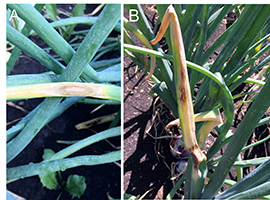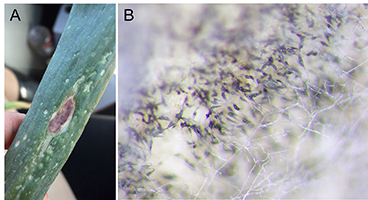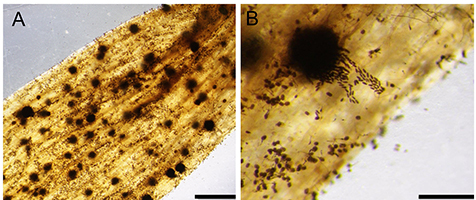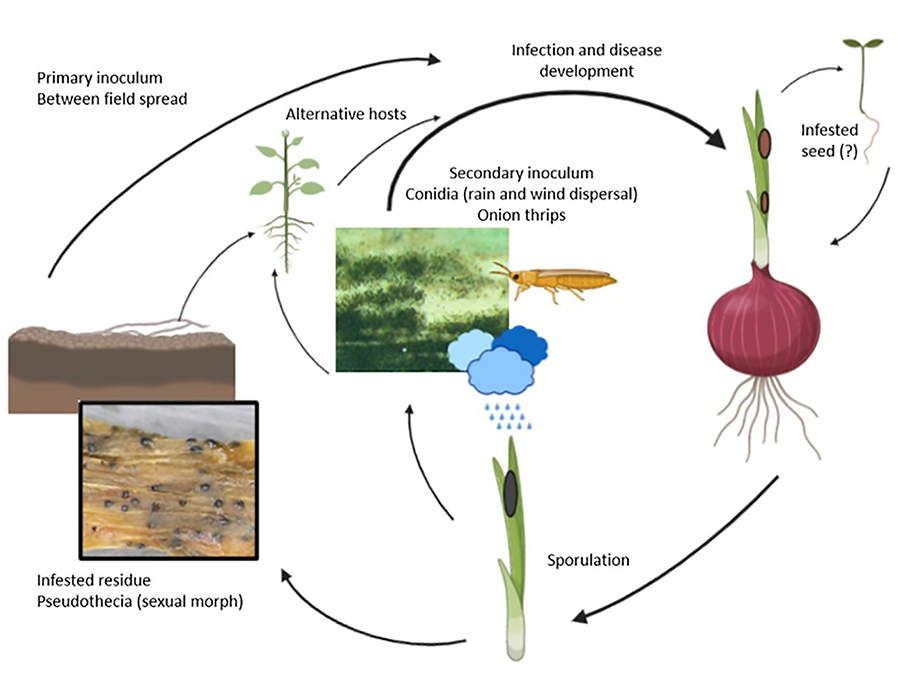DISEASE: Stemphylium leaf blight (SLB) of onion
PATHOGEN:
Stemphylium vesicarium (Wallr.) E.G. Simmons (teleomorph:
Pleospora herbarum [Pers.] Rabenh., syn.
P. allii).
HOSTS:Stemphylium vesicarium can infect a broad range of crops and weed hosts. Primary crop hosts include onion (Allium cepa L.), garlic (A. sativum L.), leek (A. porrum L.), shallot (A. cepa L. var.
aggregatum), asparagus (Asparagus officinalis L.), European pear (Pyrus communis L.), lucerne (Medicago sativa L.), mango (Mangifera indica L.), tomato (Solanum lycopersicum L.), radish (Raphanus sativus L.), sunflower (Helianthus annuus L.), parsley (Petroselinum crispum (Mill. Fuss), and soybean (Glycine max (L.) Merr.).

Figure 1. (A) Stemphylium leaf blight lesion on onion leaf.
(B) Coalescing lesions maturing from olive brown to black due to the sporulation of Stemphylium vesicarium. Images courtesy F. S. Hay and S. J. Pethybridge.
|
Symptoms and Signs
Symptoms of SLB typically begin in small, random foci usually initiated away from field edges, when bulbs are approximately 2.5 cm in diameter. In some onion fields, SLB outbreaks have been associated with volunteer onions, residue from the previous crop remaining on the soil surface, or alternative hosts. Lesions are initially small, tan to brown, and may be water-soaked, becoming spindle shaped to ovate-elongate or diffusate spots (Fig. 1A). As lesions age, the centers progress from light brown to tan in color to dark olive brown and black due to the production of conidia. Lesions may be surrounded by a light pink halo. Lesions grow in size and coalesce, leading to girdling and leaf death (Fig. 1B). Another typical symptom of SLB is necrotic dieback of the leaf tips. As the disease spreads, the lesions rapidly progress along the leaf initially in an asymmetric pattern causing longer lesions down one side of the leaves but eventually resulting in complete defoliation. Signs of
S. vesicarium (production of conidia) are commonly observed on SLB infected tissues.
Stemphylium vesicarium colonization of necrotic tips and other tissue affected by dieback is commonly referred to as 'dirty tips'.
Symptoms of purple blotch caused by the fungus,
Alternaria porri may be confused with SLB. Purple blotch symptoms first appear as small, water-soaked spots that turn brown with age, and are usually elliptical in shape (Fig. 2A). Older purple blotch lesions appear to have a target, zonate appearance, and a magenta pink-purple color. The lesion margin is often a deeper purple color and surrounded by a halo. Spores can also be easily observed in the center of purple blotch lesions.

Figure 2. Purple blotch of onion.
(A) Purple blotch lesion caused by
Alternaria porri.
(B) Asexual spores (conidia) of
A. porri produced on an onion leaf.
Spores are magnified (×40). Images courtesy F. S. Hay and S. J. Pethybridge.
|

Figure 3. Signs of
Stemphylium vesicarium.
(A) Profuse sporulation on lesions on onion leaves. (B) Conidiophore (scale bar = 10 µm). (C) Broadly oval to block-shaped conidia (scale bar = 20 µm). Images courtesy S. Sharma and D. Heck.
|

Figure 4. (A-B) Pseudothecia embedded in onion leaf residue. (C) Ascospores being released from a pseudothecium surrounded by conidia. Scale bar in both images = 20 µm. Images courtesy F. S. Hay.
|
Other foliar diseases often found in northeastern onion production include downy mildew caused by
Peronospora destructor (Palti 1989) and Botrytis leaf blight caused by
Botrytis squamosa (Carisse et al. 2011). Diagnosis can be further confused due to the ability of
S. vesicarium to invade and produce profuse sporulation in lesions of other foliar pathogens such as downy mildew. Some studies have suggested that SLB may also increase host susceptibility to other diseases. Examination of lesions with a hand lens or stereo microscope to differentiate fungal pathogens based on spore morphology is often necessary for disease diagnosis.
Stemphylium vesicarium is a dematiaceous hyphomycete fungus, meaning that it produces dark-colored spores on specialized hyphae emerging from the lesions.
Stemphylium spp. are distinguished from other fungi by the formation of multi-celled conidia with longitudinal and transverse septa (phaeodictyospores) from percurrent production of conidiophores and presence of apically swollen conidiogenous cells. Asexual spores (conidia) are prolifically produced on the lesions (Fig. 3A) and are responsible for the rapid secondary spread. Conidia typically appear on diseased tissue within 5 to 8 days, borne on conidiophores which typically arise in groups. Conidiophores are pale to mid-brown in color, up to 70 µm in length, and have dark bands or swellings from which conidia are produced (Fig. 3B). Conidia are oblong to broadly oval and sometimes inequilateral in shape, pale to light brown in color, with 1 to 5 transverse septa and 1 to 2 longitudinal/oblique septa (Fig. 3C). Conidia are often constricted at the 3 major transverse septa and have a prominent basal scar. The conidium wall is conspicuously and densely verrucose. Conidia range in size from 27 to 42 by 12 to 22 μm.
Stemphylium vesicarium is homothallic, and immature pseudothecia of the sexual morph (Pleospora allii) are often found in leaf lesions from mid- to late-season in New York. Homothallic means that both mating type loci are present within the genome of
S. vesicarium isolates; hence, a single isolate can produce these sexual structures. The pseudothecia are black, globose in shape, and up to 0.5 mm wide (Fig. 4A). Pseudothecia mature over fall/winter to produce asci containing ascospores (Fig. 4B). Asci are bitunicate and cylindrical to clavate in shape, ranging from 110 to 150 by 24 to 35 µm in size. Ascospores are uniseriate, typically ellipsoidal in shape and tapered to a point, pale yellow to brown in color, and range in size from 33 to 38 by 15 to 20 µm, with 3 to 7 transverse septa and 6 to 14 longitudinal septa. Ascospores have been observed to form in pseudothecia on leaves collected from onion fields in New York after incubation for several weeks at cold temperatures (5 to 10°C), suggesting the potential of pseudothecia to mature over winter in New York.
Pathogen Biology
Stemphylium vesicarium (Dothideomycetes: Pleosporales: Pleosporaceae: Ascomycotina) is a hemibiotroph that predominantly propagates through profuse production of conidia resulting in short-range spread. Conidia are typically dispersed by wind or rain-splash over short distances to infect through stomata or directly through the leaf epidermis. Ascospores are liberated and transported by wind to facilitate longer-range, between field spread.
Infection of onion leaves occurs after the production of terminal or intercalary appressoria, through stomata or directly through the epidermis. Appressoria are most commonly single but may be double or compound. Brown spot of pear caused by
S. vesicarium has been associated with the production of a host-specific toxin and this mechanism has been postulated to account for at least some of the symptoms associated with SLB of onion.
Disease Cycle and Epidemiology
SLB in onion may be initiated by primary inoculum from an alternative crop, weedy host, or crop residues (Fig. 5).
Stemphylium vesicarium has a broad host range including many annual and perennial crop species (e.g. pear, lucerne, soybean, tomato, and other cultivated
Allium species). In New York, broad-acre onions are often produced in a monoculture without cropping rotation. Therefore, crop residue and volunteers from the previous season are most likely sources of infection. In surveys conducted in New York,
S. vesicarium was found sporadically in and around onion fields on commonly encountered weeds, such as field horsetail (Equisetum arvense), jimson weed (Datura stramonium), field pennycress (Thlaspi arvense), and perennial sow thistle (Sonchus arvensis). Saprophytic growth of
S. vesicarium on plant debris is also common. The pathogen colonizes crop debris and produces pseudothecia and conidia. Conidia can be spread by wind and/or rain splash resulting in new infections if deposited in susceptible hosts. Multiple infection cycles from conidia result in rapid spread and polycyclic epidemics. Onion thrips (Thrips tabaci Lindeman) have also been implicated in the spread of
S. vesicarium through direct transfer of conidia (Fig. 5).

Figure 5. Lifecycle of Stemphylium vesicarium. (Image produced in BioRender.)
|
Inoculum may also be spread over long-distances resulting in between-field spread. Infested seed and transplants have been suggested as a primary means of inoculum introduction to initiate SLB epidemics (Fig. 5). Infested seed was anecdotally implicated as a driver of SLB epidemics in New York in the early 1990's. However,
S. vesicarium was not detected in 30 commercial conventional onion seedlots sourced in New York, tested by plate testing in 2016 and 2017 (F. S. Hay,
unpublished data). In New York, fields are established by seed or bare root transplants predominantly sourced from Arizona. Surveys of transplants used to establish onion fields have detected latent infection by
S. vesicarium, and early-planted transplant onion may act as a source of inoculum for direct seeded crops planted later within a region.
Disease Management
Cultural Control
Residue management is an important means to promote degradation and overwintering of inoculum between seasons. In replicated trials in New York, enhancing residue breakdown and burial of onion leaf residue after harvest was associated with significant delays in SLB epidemic initiation and progress in onion planted the following year (F. S. Hay,
unpublished data). Crop rotation to a non-host for at least one year may significantly reduce inoculum densities to reduce SLB epidemics in the subsequent onion crop.
Optimizing thrips control to prevent
S. vesicarium dispersal in onion through thrips movement and damage is also important. Reducing thrips feeding on onion plants has been shown to decrease
S. vesicarium colonization by 2.3 to 2.9 times, and SLB severity by 40 to 50%. Insecticide application for thrips control reduced SLB severity in field trials by 27%.
Given the broad host range of
S. vesicarium, best management practices for weeds within and surrounding onion fields is also recommended. The use of certified seed and clean transplants for field establishment is also advised.
Genetic Resistance
Observations in greenhouse and field trials have not identified any acceptable levels of tolerance or resistance to SLB within commercial onion varieties. Studies in Canada have hypothesized that susceptibility to SLB may be partially related to maturity with some earlier maturity cultivars being among the most susceptible. In New York, earlier maturing cultivars have been observed to have lower incidence of SLB due to harvest prior to epidemic initiation.
Fungicides
SLB and other foliar diseases affecting onion have multiple infection cycles per season and are managed within the season to reduce epidemic progress by an intensive fungicide program consisting typically of six to ten applications. Fungicides are allocated to groups based on their mode of action by the Fungicide Resistance Action Committee (FRAC;
https://www.frac.info/). For many years, foliar disease management has relied upon rotation of fungicides within FRAC groups 2 (dicarboximides), 3 (demethylation inhibitors), 7 (succinate dehydrogenase inhibitors), 9 (anilinopyrimidines) and 11 (strobilurins), and multi-site products from FRAC groups M3 and M5. For more information on FRAC groups, please refer to this lesson:
What are fungicides?
In vitro sensitivity testing of
S. vesicarium populations from NY has found evidence of resistance to fungicides in FRAC groups 2, 7, 9 and 11.
Stemphylium vesicarium populations are still sensitive to FRAC 3 (Table 1). However, this means that fungicide best management practices such as FRAC group rotation are not possible for SLB control in onion, threatening the sustainability of fungicide-based control. In addition, studies in eastern Canada suggested that seed treatment with penflufen reduced SLB severity when used in combination with foliar fungicides.
Table 1. The current (2020) status of sensitivities within the Stemphylium vesicarium population to fungicides commonly used by the New York onion industry according to site-specific modes of action defined by the Fungicide Resistance Action Committee (FRAC). Black indicates resistance is prevalent and poor field-level control; orange indicates resistance is moderately widespread and poor field-level control; green indicates efficacious in field studies but some evidence of qualitative resistance development.
|
Product |
FRAC 2 |
FRAC 3 |
FRAC 7 |
FRAC 9 |
FRAC 11 |
| Quadris | | | | |
Azoxystrobin |
| Quadris Top | |
Difenoconazole | | |
Azoxystrobin |
| Inspire Super | |
Difenoconazole | |
Cyprodinil |
|
| Rovral |
Iprodione | | | |
|
| Luna Tranquility | | |
Fluopyram |
Pyrimethanil | |
| Merivon | | |
Fluxapyroxad | |
Pyraclostrobin |
| Pristine | |
|
Boscalid | |
Pyraclostrobin |
| Endura | | |
Boscalid | | |
Scala
| | | |
Pyrimethanil |
|
Significance
In the United States, SLB epidemics on onion were first reported in Texas in 1976. In New York, SLB was first reported in 1985, considered highly prevalent in 1990, but sporadic and rare thereafter. The re-emergence of SLB as the dominant foliar disease affecting broad-acre onion production in New York has occurred over the last eight to ten years. SLB was first detected in onion fields in the Holland Marsh in Ontario, Canada in 2008 and at higher incidence annually from 2010. Re-emergence has been linked to the development of resistance to fungicides of multiple modes of action. The broad host range of
S. vesicarium likely contributes to its economic importance and complicates management.
The effect of SLB on onion yields in New York is substantial. The disease is widespread, occurring in 25 out of 25 fields surveyed in New York. In two field trials, SLB control with applications of selected fungicides led to increases of 32.5 to 39.6% in the 100-bulb weight over that of bulbs harvested from non-treated plots, and a 28.7% increase in the number of jumbo grade bulbs (> 7.6 cm diameter). SLB has also been associated with a higher incidence of bacterial bulb rot and poor shelf and storage life due to sprouting.
